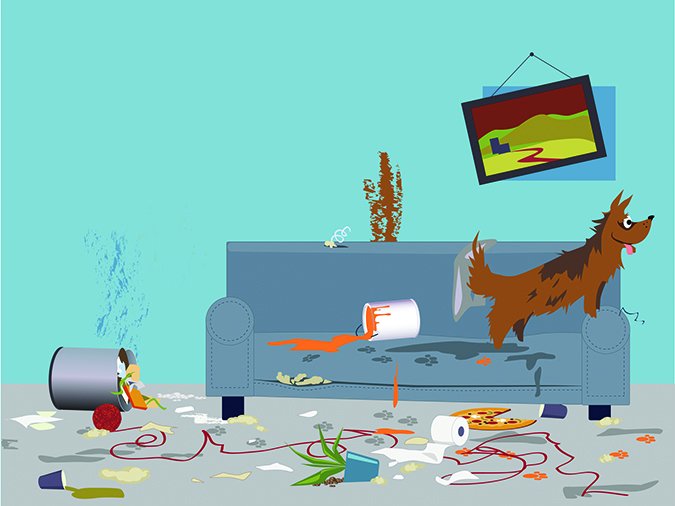I open our back door to let the dogs outside for one of their many daily bathroom breaks. Two of our dogs dash off the deck to explore our fenced yard and hunt for the groundhog who has foolishly taken up residence under the garage. In contrast, our third dog, a Cardigan Corgi named Lucy, suffers from isolation distress, a relatively mild form of separation anxiety. When she steps out onto the deck, she always looks to see whether I am following her. If I come out, she saunters off the deck, relieves her bowels and bladder, and returns to my side. If, instead, I stay inside and close the door, she nervously waits on the deck, staring through the glass panels in the door, shifting back and forth on her front paws, clearly uncomfortable, yet reluctant to venture a few feet farther away from me so she can go potty.
Separation anxiety is my least favorite behavior to deal with, as both a dog owner and a dog behavior and training professional. It is challenging to manage, has a significant negative impact on quality of life for dogs and their humans, requires a real commitment to behavior modification for a considerable period of time, and all too often results in the dog losing his happy home. That’s the bad news.
The good news is that the behavior can be modified. With a committed human in his corner, patience, and appropriate interventions, the dog suffering from this behavior can be helped.
Definitions of Separation Anxiety in Dogs
Separation anxiety is a condition in which the dog becomes upset when separated from one or more humans with whom he has hyper-bonded. A dog with true separation anxiety experiences a severe panic attack when he is left alone. Escape attempts by a dog with separation anxiety can be extreme and may result in self-injury. Household destruction often occurs, especially around exit points like windows and doors. Some dogs have even jumped through windows in their desperate attempts to find their humans.
Dogs with separation anxiety often also urinate and/or defecate in the house when left alone. This is a stress response, and is not an attempt to “get even” with their humans for being left alone. Dogs should never be punished or even scolded for their separation-related behaviors. This will only stress them more and worsen their anxiety.
Separation-related behaviors vary in intensity from one dog to the next. Milder forms of the behavior are more appropriately called “separation distress,” while the full-blown panic attack truly deserves the label “separation anxiety.”
A slightly less difficult presentation of this behavior is known as isolation distress or anxiety. With true separation distress or anxiety, the dog must specifically be with one of the humans to whom he has hyper-bonded. A dog with isolation distress or anxiety only needs not to be left alone. For some dogs, this need can even be met by the presence of another animal. Clearly, this is an easier behavior to work with. And thankfully, our Lucy only has a mild level of isolation distress.
Behaviors of Dogs with Separation Anxiety
Typically, symptomatic behaviors may begin either as the anxious dog’s human prepares to depart, or immediately after they leave. The behavior may continue for 30 to 60 minutes or longer, and in more extreme cases, for the entire length of the owner’s absence – even as much as eight to 10 hours.
Destructive behavior is one of the most obvious and difficult signs of separation or isolation anxiety (SA or IA), but it is not the only one. Here are others that can be seen in some (but not all) dogs with SA or IA:
1. Velcro Dog
SA and IA dogs tend to be clingy even when owners are home – following their humans from room to room, and lying as close as possible when owners are seated. The dog may also frantically try to follow his human every time she walks out the door, even if she’s just going out to get the mail or newspaper.
2. Pacing
As you make preparations to leave, your dog recognizes the pending event, and begins to stress – often pacing, panting, and whining in anticipation of your departure.
3. Vocalization
It is not uncommon for SA/IA dogs to be very vocal when their humans are gone.
4. House Soiling
Extreme stress can cause your dog to urinate and defecate indoors. He can’t help it.
5. Anorexia
Many dogs with SA/IA will not eat or drink when left alone. (This renders the often-given suggestion to give the dog a food-stuffed Kong or other toy relatively useless.)
6. Crate Intolerance
Dogs with SA/IA often will experience an even greater degree of panic if they are confined in a crate. Dogs who are destructive in the home due to immaturity and/or lack of house manners are often crated to protect the home, but this is generally not a viable option for SA/IA dogs. Panicked dogs have injured themselves and even died in the process of trying to escape from their crates.

7. Excessive Excitement Upon Owner’s Return
Of course, lots of our dogs are excited when we come home. The SA/IA dog may present an extreme level of arousal and excitement upon his human’s return; owners are cautioned to remain very calm, rather than getting excited in response.
Causes and Triggers of Dog Separation Anxiety
We don’t really know what causes separation and isolation anxiety, although it’s likely that dogs who do develop the behavior have a genetic propensity for it. Some dogs show evidence of the behaviors from early puppyhood; others not until later in life.
We do know that this behavior is overrepresented in dogs adopted from shelters, but we don’t know if it’s because the stress of being in the shelter triggers the anxiety, or if they are surrendered to shelters in greater numbers because of their difficult behaviors. We also know that the behaviors can be brought on by other dramatic or traumatic events in a dog’s living environment. These dogs often also have other anxiety-related behaviors, such as storm sensitivities.
Here are some known triggers for canine separation anxiety and isolation anxiety:
Schedule Change
A sudden change in the length of time a dog is left alone, or in the time of day he is left alone, can sometimes trigger SA or IA. When a schedule change is anticipated in advance, if possible, take time to help your dog acclimate gradually. If you’re switching from day shift to night shift at your job, take several days off work and use them to gradually change the hours you are away from home. As you transition to later hours, you might even think about spending a night or two at a motel or a friend’s house, so your dog can experience your absence at night in progressively longer stretches.
Moving
The stress involved in a household move, combined with the lack of familiarity with the new home, can trigger SA or IA in some dogs. Of course it’s not always possible, but if you’re planning a move and you have the luxury of being able to spend time in the new home with your dog prior to the actual move, the change will be less traumatic for him, and less likely to trigger anxiety-related behaviors.
Loss of Family Members
The sudden loss of a family member – a child going off to college, someone moving away, or a death in the family – can elicit anxiety in your dog, especially if the person leaving was particularly well loved by the dog. Again, when possible, make these transitions gradual, so your dog has time to adjust to the change.
Rehoming
Whether he’s been surrendered to a shelter or privately rehomed, getting a new home and owner is a huge life change for a dog. As much as we would love for all dogs to spend their entire lives in one forever home, there are some legitimate circumstances that require rehoming. Again, the more that can be done to prepare a dog for a new home, the better. If you know the person who will be adopting your dog, arrange for her to meet your dog and share several enjoyable outings with him, so your dog gets to know her before the move, and so you can be sure they are compatible.
If you’re surrendering your dog to a shelter, there’s not a lot you can do to help him acclimate to a shelter environment. But you should, at least, do some research to be sure you are giving him to a well-run, bona fide shelter or rescue group, not a hoarder posing as a rescue, or a flipper who sells dogs (they exist!).
If you are the new home, schedule gradually increasing departures for the first week or two when you bring the puppy or dog home to help prevent this.
Traumatic Event
Anything that creates a high degree of stress for your dog has the potential to trigger SA or IA. A burglar breaking into the house while the dog is home, a fire in the house next door with loud sirens and general chaos nearby, an earthquake, even a close lightning strike, can have long-term effects on a dog’s anxiety level.
Separation Anxiety Behavior Modification
Behavior professionals generally agree that it’s difficult if not impossible to modify unwanted behaviors if the dog is allowed to continue to practice them. Management is generally the answer to preventing your dog from practicing unwanted behaviors.
That said, management for IA and especially SA can be very difficult. This makes behavior modification for SA and IA a real challenge, as most people don’t have the luxury to be able to take several weeks off work to implement a gradual program of counter-conditioning and desensitization for their dogs. However, the closer you can come to that ideal, the more successful you will be at helping your dog learn to be comfortable staying home alone.
The management piece is the main reason isolation anxiety is easier to deal with than separation anxiety. You can leave a dog who has IA at a good doggie daycare facility, with a friend or family member, or sometimes with other dogs for sufficient companionship, and he will be perfectly happy. Not so with dogs who have SA. Because this dog has to be with you, he will be just as unhappy at daycare or your mom’s house as he is at home – and the daycare operators and your mother are likely to be very unhappy as well!
Dog owners have long been counseled to desensitize their dogs to pieces of the departure routine, so that each piece is less likely to raise the dog’s stress level. Pick up your keys and set them down throughout the day. Put on your coat and take it off. Put your shoes on and take them off. All this can be helpful, especially with milder cases. However, it’s not likely to deter a dog who has a significant case of SA or IA.
Serious SA/IA modification consists of very gradual counter-conditioning and desensitization to small increases in distance between the dog and his human. We have a saying in behavior modification, “If you think you are going too slow, slow down.” For SA and IA modification, you need to slow down even more.
Trainer/author Malena DeMartini-Price has specialized in separation anxiety since 2001, and has written an excellent book on the subject, Treating Separation Anxiety in Dogs. She also offers a training program that certifies trainers who seek to work with cases of SA and IA. Her treatment protocol is divided into five phases. To highlight how slowly a successful modification program goes, she says, “You won’t progress to the next phase until the dog is truly successful in the previous one … For example, if a dog can’t successfully stay behind a baby gate for a few minutes while Mom is out of sight (Phase 3), you can’t advance to the next phase.”
If you are looking for a trainer to help you with your dog’s SA/IA behavior, you can connect with a Certified Separation Anxiety Trainer (CSAT) by visiting this link.
Veterinary Behaviorist Dr. Karen Overall has created a 15-day protocol (she calls it “Protocol for Relaxation”) that is perfect for SA and IA (although I caution my clients that it is likely to take far longer than 15 days). For each task on the list, you ask your dog to sit and stay, or lie down and stay. At the conclusion of each task in the list, you feed your dog a treat, tell him stay again, and perform the next task. The protocol can also be helpful for modifying crate anxiety behaviors.
To give you an idea of how slowly you move through the exercises, here is Dr. Overall’s list of tasks to do with your dog on day one:
Day 1: Dog’s Task
1. Sit for 5 seconds
2. Sit for 10 seconds
3. Sit while you take 1 step back and return
4. Sit while you take 2 steps back and return
5. Sit for 10 seconds
6. Sit while you take 1 step to the right and return
7. Sit while you take 1 step to the left and return
8. Sit for 10 seconds
9. Sit while you take 2 steps back and return
10. Sit while you take 2 steps to the right and return
11. Sit for 15 seconds
12. Sit while you take 2 steps to the left and return
13. Sit while you clap your hands softly once
14. Sit while you take 3 steps back and return
15. Sit while you count out loud to 10
16. Sit while you clap your hands softly once
17. Sit while you count out loud to 20
18. Sit while you take 3 steps to the right and return
19. Sit while you clap your hands softly twice
20. Sit for 3 seconds
21. Sit for 5 seconds
22. Sit while you take 1 step back and return
23. Sit for 3 seconds
24. Sit for 10 seconds
25. Sit for 5 seconds
26. Sit for 3 seconds
Slow going, right? Each of the subsequent days takes you gradually farther and farther away from your dog, for increasingly long periods of time. At the end of the protocol you are out of sight (in another room) for 10 seconds. Obviously, you would need to continue your work from there to gradually build up to leaving the house for increasing periods of time. It’s not an easy task.
I also tell my clients they can break it down into even smaller steps if necessary to help their dog succeed. For example, rather than going from 5 seconds (the first task below) to 10 seconds (the second task) they could start at 3 seconds and just increase the difficulty by one second at a time.
Karen Overall’s entire protocol is available online.
Separation Anxiety Medication for Dogs

Some humans are reluctant, for various reasons, to use medication for canine behavior problems. With most of my clients whose dogs do not have IA or SA, we agree to implement a behavior modification plan, and we usually start to see changes in behavior in reasonably short order. Not so with dogs who have severe anxiety issues. The quality of life for these dogs (and for their humans) is usually so poor that we need to relieve their anxiety as quickly as possible – and the right medication can go a long way toward doing that.
However, medication alone won’t fix the problem. The purpose of behavior modification drugs is to increase the ability of your dog’s brain to receive behavior modification efforts. Stress impairs learning ability, and a dog who is super-stressed (anxious) can’t learn well or easily, so the appropriate medication can be a lifesaver for these dogs.
Identifying SA or IA in your dog early on and addressing it appropriately can make a huge difference in his quality of life – and yours. Hoping that your dog’s undesirable behavior is due to some other cause, and delaying the implementation of effective steps to manage his anxiety may worsen the situation dramatically.
I know this from personal experience. We misjudged the reason for our Lucy’s barking on the back deck when she was young (a year old) and left her outdoors for a period of time in order to not reinforce what we thought was her demand barking to come in. Later, we ascertained that the barking was, in fact, due to isolation anxiety – but this was only after Lucy, in her frantic efforts to get to us, fell off a stone wall, ruptured her left ACL, sprained her left front wrist, and tore the ligaments in her left shoulder. She recovered from her injuries, and sadder but wiser, we took a much gentler approach to helping her learn to be alone.
We still don’t leave her in the backyard unattended, but she is able to be crated and/or left in my office with a baby gate across the door. She won’t eat or drink when left alone, but she doesn’t bark, isn’t destructive, and doesn’t hurt herself. And that’s a huge improvement! We’re all much happier.
The Right Medication for Your Dog
I am not a veterinarian. Therefore, I should not – and legally cannot – tell you what medication or medications you should use for your dog’s isolation or separation anxiety.
I can tell you, however, that most veterinarians do not study behavior in vet school (it is not required at most colleges that offer veterinary medical degrees), and many of them have no more idea than I do (and some of them less) what medications might be appropriate. Many of them are likely to just reach for the same drug they’ve always used, or the one that was promoted most effectively during a recent visit by a drug company representative. I can also tell you that Dr. Karen Overall says that acepromazine is exactly the wrong drug for most behavior modification purposes, and yet it’s the one that many veterinarians reach for simply because it’s been around a long, long time.
There is a small group of veterinarians who have studied behavior and have taken and passed the “boards” – an examination that allows them legally to call themselves “veterinary behaviorists.” There is another small group of veterinarians who specialize in behavior and, although they are not “boarded” in behavior, are educated enough (and know when to ask for help) to make good decisions about the best, most appropriate medication for your dog’s behavioral issues. Prescribing behavior drugs is an art as well as a science. These veterinarians who specialize in behavior are the artists, and fortunately for us they are happy to share their talents.
Most of them are more than willing to do free phone consultations with other veterinarians who are seeking advice on which drugs (and what dosages) they should use for client dogs with behavioral issues such as SA and IA. Any time I start talking drugs with my clients, I urge them to insist their vet take advantage of this service and reach out to a veterinary behaviorist for guidance. I urge you to do the same.
There aren’t very many of them – and your vet may not be able to find one local to you. But they don’t have to be, since they are all just a phone call away. The current list of veterinary behaviorists can be found by following this link.
Remember … insist.







Thank you so much for that very valued article…. my mini yorkie was my husband’s carry everywhere baby.. he now follows me everywhere from room to room when my helper is here, he tried to bite his jeans and guards his food. When we go for our daily poopoo walk he thinks he is a rotweiler and scratches and smells everything, we visit our neighbours big dogs daily and he loves them. He has developed a great fear for lightning because my house had a direct lightning hit, so i do give him Rescue tabs when i am aware of bad weather and lighting. He does have a fear of being alone when i go shopping but i dont make an issue of it, even when i come home… What am i doing wrong…???
Thank you. I wish every dog owner could read this. I have seen several dogs dumped at shelters, or advised by trainers to be crated to deter the destructive behavior even when the dogs went berserk in the crates and got even more traumatized. I think the crating advice doled out so casually is criminal, unethical and cruel. Since the advice comes from “professionals” far too many dogs are tortured in this manner. The Humane Society finally came out with a warning/advisory to never crate a dog with separation anxiety as it exacerbates the situation. Sadly, few have gotten the message.
But what are you supposed to do then? My dog is destructive if left alone in the house (even overnight with us here). I can’t live in an empty house!
She’s not a velcro dog (she’s fine if I’m in one room and she’s in another during the day).
Thank you so much for that very valued article…. my mini yorkie was my husband’s carry everywhere baby..